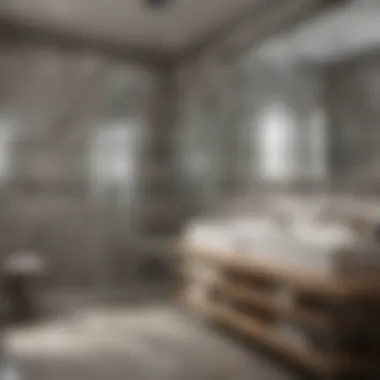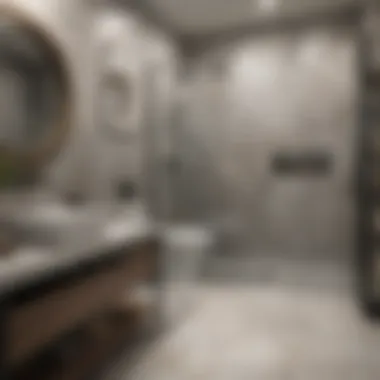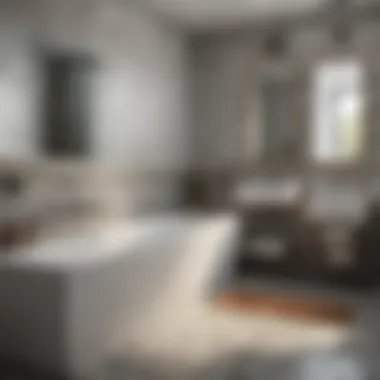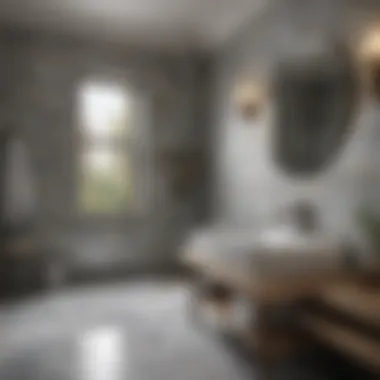Mastering 12x24 Bathroom Tile Layouts for Style


Intro
Bathrooms serve as spaces for both relaxation and functionality. The choice of tile can significantly influence this balance. 12x24 tile sizes are increasingly popular in modern bathrooms. These tiles offer versatility in design and layout, allowing for creative arrangements that enhance the room's aesthetics while remaining practical. This guide will explore varied layouts, installation methods, and key considerations when using 12x24 tiles in bathrooms.
Understanding how to select the right tile layout can elevate a bathroom from mundane to extraordinary.
"The right tile layout can profoundly impact the overall ambiance of your bathroom, making it feel more spacious and inviting."
The following sections will delve into design inspirations and essential recommendations, focusing on the trends that are shaping contemporary bathroom renovations.
Prolusion to 12x24 Bathroom Tiles
The choice of tile in a bathroom is more than just aesthetic; it affects the overall functionality and style of the space. 12x24 bathroom tiles have gained traction among homeowners and designers alike for their versatility. This guide provides insights into how these tiles can transform your bathroom.
Understanding Tile Dimensions and Their Significance
Size matters when it comes to tile selection. The 12x24 dimension is considered large format, which provides several advantages over smaller tiles. Large tiles mean fewer grout lines, which creates a cleaner look and makes the space appear larger. Additionally, fewer grout lines lead to reduced maintenance as there is less surface area to clean. The rectangular shape offers design flexibility, allowing for various laying patterns that can influence the perception of space.
Why 12x24 Tiles Are Popular in Bathroom Design
There are multiple reasons why 12x24 tiles have become a favored choice in bathroom design. Firstly, these tiles create a sleek and modern appearance that complements a variety of decor styles. Secondly, their ability to mimic natural stone or wood looks appeals to homeowners seeking elegance without the high cost. Moreover, the large size helps in minimizing cut waste during installation, making it a cost-effective option when properly planned.
The combination of aesthetics and functionality makes 12x24 tiles a smart choice for bathrooms of all sizes.
Ultimately, the decisions around tile layout should be informed by both design goals and practical considerations. Assessing how 12x24 tiles can meet these needs lays a solid foundation for further exploration of this topic.
Types of 12x24 Bathroom Tiles
The selection of tile type plays a pivotal role in bathroom design. Each type of 12x24 tile offers distinct attributes that can affect both appearance and functionality. Knowledge of these types enhances decision-making and allows for an informed choice that aligns with aesthetic and practical needs.
Ceramic Tiles
Ceramic tiles are a staple choice for bathroom flooring. They offer durability and a range of design options. Typically, these tiles are less expensive compared to other materials, making them accessible for many homeowners. Their resistance to moisture is crucial in a bathroom setting, as it helps to prevent mold and mildew. Moreover, ceramic tiles come in various colors and finishes, allowing for personalization in design. However, it is worth noting that ceramic can chip or crack if heavy objects are dropped on them. This potential drawback should be considered during installation and everyday usage.
Porcelain Tiles
Porcelain tiles are another excellent option for bathroom tiles. They are denser and less permeable than ceramic, which enhances their durability. This tile type can withstand heavy traffic and is less likely to sustain damages, such as cracking. Porcelain tiles can mimic the look of natural stone, providing aesthetic versatility. Maintenance of these tiles is relatively easy, as they resist staining more effectively than other materials. A crucial point to consider is that porcelain tiles can be more expensive, which may affect budget decisions.
Natural Stone Tiles
Natural stone tiles, including granite, marble, and slate, present a unique charm for bathroom spaces. Their varied textures and colors contribute to a luxurious appearance. Each stone tile is one of a kind, ensuring a distinct look in every installation. However, natural stone can be porous and often requires sealing to prevent water absorption and staining. Regular upkeep is vital to preserve their beauty and durability. While they can elevate design, homeowners must keep in mind the higher cost and maintenance associated with natural stone selections.
Vinyl Tiles
Vinyl tiles have gained popularity in the bathroom due to their affordability and ease of installation. They come in various designs, some of which can even replicate the look of natural materials like wood or stone. Vinyl is water-resistant, making it a practical choice for bathrooms. Its softer surface can be easier on the feet compared to hard tiles. However, quality can vary, and some lower-cost options may not withstand heavy moisture as effectively as other tiles. Therefore, it is essential to choose high-quality vinyl tiles to ensure longevity.
Choosing the right type of 12x24 tile involves weighing these benefits and considerations carefully. The right choice can contribute significantly to the overall functionality and aesthetic appeal of the bathroom.
Layout Patterns for 12x24 Tiles
Layout patterns are a critical aspect of utilizing 12x24 tiles effectively in bathroom designs. The arrangement and placement of tiles can dramatically influence the perception of space, style, and visual appeal. Each layout pattern offers unique benefits and can cater to diverse preferences and bathroom sizes. Selecting the right pattern not only enhances aesthetics but also contributes to practical considerations such as maintenance and installation complexity.
Straight Lay
Straight lay is the most common and straightforward tile installation method. In this approach, the 12x24 tiles are set in straight rows, parallel to the walls. This pattern creates a clean, modern look that appeals to many homeowners. One of the significant advantages of this layout is its simplicity, making installation easier and quicker, reducing labor costs.


However, while the straight lay offers many benefits, it has limitations in visual variety. It's best suited for larger bathrooms where the simplicity can emphasize spaciousness. Additionally, it works well with various color combinations and tile finishes, providing a versatile backdrop for bathroom design.
Staggered Pattern
The staggered pattern randomizes tile placement to give a more dynamic appearance. Unlike the straight lay method, this pattern offsets adjacent rows, creating a brick-like arrangement. This layout is ideal for minimizing visible grout lines, thus enhancing the overall aesthetic.
A staggered layout is particularly effective in adding character to the bathroom. Homeowners often appreciate this design for its ability to disguise imperfections in the substrate. Installation might require more diligence in terms of alignment, but the end result is often worth the effort, particularly in smaller spaces that benefit from an illusion of depth.
Herringbone Design
Herringbone design is characterized by its distinctive V-shaped pattern formed by the 12x24 tiles. This layout adds a touch of sophistication and is perfect for homeowners looking to create a unique statement in their bathroom. The design typically works best in a rectangular space, allowing for visual elongation.
While this pattern looks visually stunning, it can be more complex to install compared to the straight lay or staggered patterns. The intricate cuts and precise placement are crucial to achieving its distinctive style. However, for those willing to invest the time and effort, the herringbone design brings depth and elegance to any setting.
Grid Layout
The grid layout arranges tiles in a uniform pattern, where tiles are set both vertically and horizontally. This method is often seen in minimalist bathroom designs. A grid layout can create a structured appearance and is straightforward to install, making it a popular choice for those who prefer simplicity without sacrificing style.
This pattern can make a small bathroom feel larger, as the uniformity draws the eye across the floor or wall. However, it may not offer the same level of visual interest as other more complex patterns. Homeowners can enhance a grid layout by thoughtfully choosing contrasting grout colors to highlight the pattern itself.
Diagonal Placement
Diagonal placement involves laying the tiles at a 45-degree angle to the walls. This technique introduces a unique visual effect that can make a space feel more dynamic and larger. Diagonal layouts are excellent for smaller bathrooms, as they can lead the eye through the space, creating an illusion of breadth.
However, this type of installation may require more tile cutting and waste, making it potentially less cost-effective. It also may take more time to execute precisely. For homeowners looking for a fresh and modern approach, diagonal placement offers a striking alternative to traditional layouts.
"Choosing the right tile layout can significantly enhance both the functionality and visual appeal of your bathroom."
Considerations for Choosing Tile Layouts
When selecting a tile layout for a bathroom, the decisions made can significantly influence both functionality and aesthetics. The choice of layout is not only about visual appeal; it impacts how the space feels and operates. By understanding the key considerations, homeowners can create an environment that meets their practical needs while also reflecting their personal style. This section dissects the essential factors that should guide your layout decisions.
Size of the Bathroom
The dimensions of the bathroom dictate much about the tile layout. 12x24 tiles can create an illusion of space in smaller areas. The alignment of these larger tiles might draw the eye upward, making the ceiling appear taller. In larger bathrooms, however, more complex patterns can be employed without overwhelming the space. It’s essential to consider the scale of the tiles in relation to the room size. To illustrate, larger tiles might suit expansive bathrooms where complex designs could enhance visual interest.
Tip: Proper measuring is crucial. Miscalculated dimensions can lead to poor installation, affecting aesthetics and functionality.
Lighting and Color Scheme
Lighting can transform how tiles are perceived. Natural light can enhance the colors and textures of 12x24 tiles, while artificial light may cast shadows that alter their appearance. For example, glossy tiles reflect light, giving a brighter look, while matte tiles offer a more subdued ambience. Moreover, the color scheme of the bathroom plays a vital role. Light colors tend to make a space feel larger, whereas darker shades can introduce a sense of coziness. Pairing tiles with complementary colors or patterns can yield stunning results.
- Bright colors amplify light and space.
- Darker tones can create a dramatic effect.
Desired Aesthetic
Personal aesthetic is perhaps the most subjective yet significant aspect in choosing tile layouts. Some homeowners may prefer a modern minimalist approach, utilizing simple straight lays, while others might lean towards more elaborate designs, such as herringbone. The choice of tile layout should align with overall design themes—rustic, contemporary, or transitional. Consider how the tile layout will harmonize with fixtures and fittings in the bathroom. The aim should be to ensure cohesiveness in style.
When planning the desired aesthetic, sketching possible layouts may help visualize the outcome before major decisions are made. Remember, each layout contributes uniquely to the overall feel of the bathroom space.
Preparation and Installation Process
The Preparation and Installation Process is a critical phase in achieving a successful tile layout. Many homeowners overlook this step, often leading to unforeseen challenges. Proper preparation enhances durability, ensures aesthetic appeal, and simplifies future maintenance. Whether you are a seasoned DIYer or new to tiling, understanding these processes can lead to a significantly improved finished product.
Tools Required for Tile Installation


Having the right tools is essential for tile installation. Using inappropriate tools can result in uneven tiles or damage to the material. Here are some basic tools you will need:
- Tile cutter: They can be manual or electric. A wet tile saw is preferable for longer or thicker tiles such as 12x24.
- Notched trowel: This tool is vital for spreading adhesive evenly on the back of tiles.
- Level: A level ensures your tiles are laid straight, avoiding a slope or uneven surfaces.
- Grout float: Used to apply grout into the spaces between tiles after they are set.
- Measuring tape: Accurate measurements are crucial for planning the layout and cutting tiles appropriately.
These tools maximize efficiency and contribute to a flawless installation.
Surface Preparation Techniques
Preparing the surface is another key consideration. A clean, smooth, and dry surface is crucial for tile adhesion. Here are steps to ensure your surface is ready:
- Remove old flooring: If a previous floor exists, it must be completely removed.
- Clean thoroughly: Remove dust, debris, or any substances that may hinder adhesion.
- Repair damaged areas: Fill any cracks or holes in the subfloor. A level subfloor will ensure your tiles stay even.
- Use underlayment if needed: In some cases, installing a layer of underlayment can provide extra support and improve sound insulation.
Proper surface preparation cannot be stressed enough; it greatly affects the durability of your tile work.
Cutting Tiles for Fitting
Cutting tiles is often necessary to fit them properly around edges, corners, and fixtures. A few tips for effective cutting include:
- Measure twice, cut once: This old adage holds true in tile work. Always double-check your measurements before cutting.
- Use a tile cutter: For straight cuts, a manual or electric tile cutter works well. For curved cuts, specialized tools may be needed.
- Smooth edges: After cutting, use a rubbing stone or a diamond pad to smooth the cut edges. This step helps prevent chips and creates a neater finish.
Cutting tiles accurately will influence the visual appeal and overall integrity of the layout.
Applying Adhesive and Setting Tiles
The application of adhesive and the setting of tiles are critical actions in your installation process. Here’s how to do it right:
- Mix adhesive according to instructions: Follow the manufacturer's specifications for mixing. It is crucial to get this step correct for proper adhesion.
- Spread adhesive with a notched trowel: Use the notched side to create grooves that help with tile adhesion. Work in sections to prevent the adhesive from drying before laying tiles.
- Press tiles into place: Set each tile carefully, ensuring they are aligned with your layout. Use spacers for uniform gaps between tiles if needed.
- Check alignment frequently: As you set each tile, use a level to ensure they remain even and aligned with one another.
Following these steps is crucial for achieving a professional-looking installation.
"Preparation is the key to success, particularly in the realm of tile installation. A well-prepared surface and the right tools foster a smooth process and optimal results."
By focusing on these essential components in the Preparation and Installation Process, homeowners can achieve a seamless and durable tile layout that enhances their bathroom aesthetic as well as functionality.
Maintaining 12x24 Bathroom Tiles
Maintaining 12x24 bathroom tiles is essential for ensuring their longevity and aesthetic appeal. Proper care involves routine cleaning, grout maintenance, and restoration techniques tailored to the unique properties of the tiles. Ignoring irregular upkeep can lead to dirt buildup, weakened grout, and overall tile deterioration. It is especially vital for homeowners and housewives who wish to keep their bathrooms looking pristine and functional. Establishing a system of regular maintenance can save not only time but also costly repairs in the long run.
Routine Cleaning Practices
Routine cleaning is fundamental to preserving the appearance and durability of 12x24 bathroom tiles. Regular cleaning removes dust, grime, and soap scum that accumulate daily. For effective cleaning, the following practices are recommended:
- Use Mild Cleaners: Opt for pH-neutral or mild cleaners to avoid damaging tile surfaces. Harsh chemicals can strip finishes or compromise tile integrity.
- Soft Cleaning Tools: Always use soft cloths or mops instead of abrasive scrubbers. Abrasive materials can scratch tiles, leading to dullness and increased wear over time.
- Frequent Cleaning Schedule: Establish a cleaning routine, perhaps weekly or biweekly, depending on bathroom usage. Consistency helps prevent stubborn stains from forming, making cleaning easier.
"Regular cleaning not only enhances the visual appeal but also prolongs the life of tiles."
Addressing Grout Maintenance
Grout maintenance is another crucial aspect of tile upkeep. Grout joints can easily gather dirt and mold if left unaddressed. Here are some tips for maintaining grout effectively:
- Sealing Grout: Applying a grout sealer after installation and occasionally thereafter can protect against stains and moisture infiltration.
- Cleaning Grout Lines: Consider using a mixture of baking soda and vinegar or a dedicated grout cleaner for effective cleaning. Scrubbing gently can prevent damage and keep lines looking fresh.
- Repairing Cracked Grout: If cracks appear, prompt repairs are necessary. Use a grout repair kit to fill damaged areas, ensuring a uniform appearance and preventing water damage.
Tile Restoration Techniques
Tile restoration techniques become relevant when tiles lose their original luster or if physical damage occurs. Certain methods can revitalize the tile surface effectively:


- Polishing Tiles: For materials like porcelain or natural stone, polishing can restore shine. Specialized tile polish can enhance aesthetics without causing any harm.
- Re-grouting: If grout lines become discolored or damaged over time, re-grouting may be necessary. This process involves removing old grout and applying fresh grout, which refreshes the entire tile appearance.
- Professional Cleaning Services: For extensive damage or complex restoration needs, consider hiring a professional tile restoration service. They have specialized tools and knowledge that can revive even the most neglected spaces.
Efficient maintenance and restoration of 12x24 bathroom tiles are key to preserving the visual appeal and functionality of this vital space. Homeowners can ensure that their investment remains vibrant and resilient with proper care and maintenance.
Common Mistakes in Tile Layout
Creating a visually appealing and functional bathroom using 12x24 tiles can be an exciting challenge. However, mistakes during the design and installation process can undermine your efforts. Understanding common pitfalls is essential for achieving the best results. In this section, we will discuss specific elements that can lead to issues and provide valuable insights to help you avoid them.
Improper Measurements
Measurements are the foundation of any successful tile layout. Common mistakes occur when measurements are inaccurate or miscalculated. It is crucial to measure the space carefully before purchasing tiles. Consider both the wall and floor areas to cover.
To avoid improper measurements:
- Use a level and a measuring tape to ensure accuracy.
- Double-check your numbers, as miscalculations can lead to purchasing insufficient or excessive tiles.
- Account for cut tiles when considering the layout. Knowing how many tiles will cover your area helps in ordering the correct quantity.
Neglecting to plan and measure correctly can lead to odd-looking patterns or require returning excess materials, ultimately raising costs and impacting your timeline.
Neglecting Drainage Considerations
Drainage is an often-underestimated aspect of flooring design, but it is pivotal in wet areas like bathrooms. When laying tiles, a slight slope may be necessary to channel water effectively toward the drain.
Ignoring drainage can cause pooling and water damage, which compromises the tile integrity and leads to costly repairs.
To ensure proper drainage:
- Plan your layout with slope in mind. A minimal slope can often be achieved by adjusting your tile placement.
- Inspect your bathroom structure to identify any existing slopes or shifts in the surface. This information should inform your installation.
Prioritizing installation with drainage concerns will ensure longevity and performance of your tiles in the bathroom.
Ignoring Tile Orientation
The orientation in which tiles are laid can significantly affect the visual appeal and perceived space of your bathroom. Common mistakes occur when the tile orientation does not complement the room's shape or lighting.
To make the best choice regarding tile orientation, consider:
- Laying tiles in the same direction as the longest wall to create a more expansive appearance.
- Experimenting with different orientations, such as herringbone or brick-shaped layouts, to find the one that best fits your design goal.
- Ensuring a consistent pattern throughout the space for coherence. Inconsistent orientation can create a discordant look.
By paying attention to tile orientation, you can enhance the overall aesthetic and functionality of your bathroom.
Proper planning and awareness of common mistakes in tile layout can save time, resources, and ultimately lead to a beautifully designed bathroom.
Epilogue
As we conclude our detailed examination of 12x24 bathroom tile layouts, it is essential to reflect on the significance of this topic. Understanding how to effectively utilize 12x24 tiles contributes substantially to the overall design and functionality of a bathroom space.
The ease of installation, coupled with the aesthetic appeal of these large-format tiles, makes them a preferred choice for homeowners and designers alike. They can visually extend space, making smaller bathrooms appear larger and more open. Choosing the right layout can also influence the flow and harmony of the bathroom.
When selecting a tile layout, considerations such as room size, lighting, and the desired overall aesthetic must be weighed carefully. Proper planning is key to avoiding common mistakes, which can lead to costly revisions and frustration during installation.
The beauty of 12x24 tiles lies not just in their size but in how they can transform an ordinary bathroom into a personal sanctuary.
In summary, the 12x24 tile offers a compelling combination of beauty and practicality. The right layout not only enhances visual appeal but also provides a blank canvas on which to build a cohesive bathroom design. By utilizing the insights shared in this article, homeowners can make informed decisions that elevate their spaces to new heights.
Final Thoughts on 12x24 Tile Layouts
Practicing thoughtful design—considering layout patterns such as straight lay, staggered, or herringbone—can enhance any bathroom environment. The choice of tile material, be it ceramic or natural stone, further influences how these tiles behave in different settings.
For those undertaking a remodel or new construction, investing time in planning out the layout is crucial. This not only eliminates potential installation errors but also ensures the finished space aligns with the homeowner's vision. Efforts in maintenance and care can prolong the life of these tiles, making them a sound choice for long-term investment.
Ultimately, embracing 12x24 bathroom tiles can lead to impressive transformations, both functionally and aesthetically.



